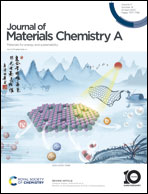A 3D-printed Al metal–organic framework/S cathode with efficient adsorption and redox conversion of polysulfides in lithium–sulfur batteries†
Abstract
Lithium–sulfur (Li–S) batteries attract extensive attention owing to their high energy density, low cost, and environmental friendliness. However, Li–S batteries suffer from low conductivity, polysulfide dissolution, and huge electrode expansion. Constructing hierarchically micro-nanostructured and porous cathodes through 3D printing (3DP) technology can address these issues and improve electrochemical performance. Herein, a hierarchically micro-nanostructured Al-MOF/S cathode is constructed by 3DP technology for Li–S batteries. The hierarchically porous 3DP Al-MOF/S cathode can promote electrolyte penetration, facilitate electron/ion transport, improve sulfur utilization, prevent polysulfide shuttling, and buffer electrode expansion. It is worth noting that when the sulfur loading is 2.73 mg cm−2, the 3DP Al-MOF-160/S cathode demonstrates an initial discharge capacity of 1171 mA h g−1 and a reversible capacity of 504 mA h g−1 after 300 cycles at 0.1 C. Furthermore, the 3DP Al-MOF-160/S cathode with a sulfur loading of 15.85 mg cm−2 possesses a discharge capacity of 531.4 mA h g−1. Besides, this work can provide insight into developing 3DP cathodes for Li–S batteries.

- This article is part of the themed collection: #MyFirstJMCA


 Please wait while we load your content...
Please wait while we load your content...